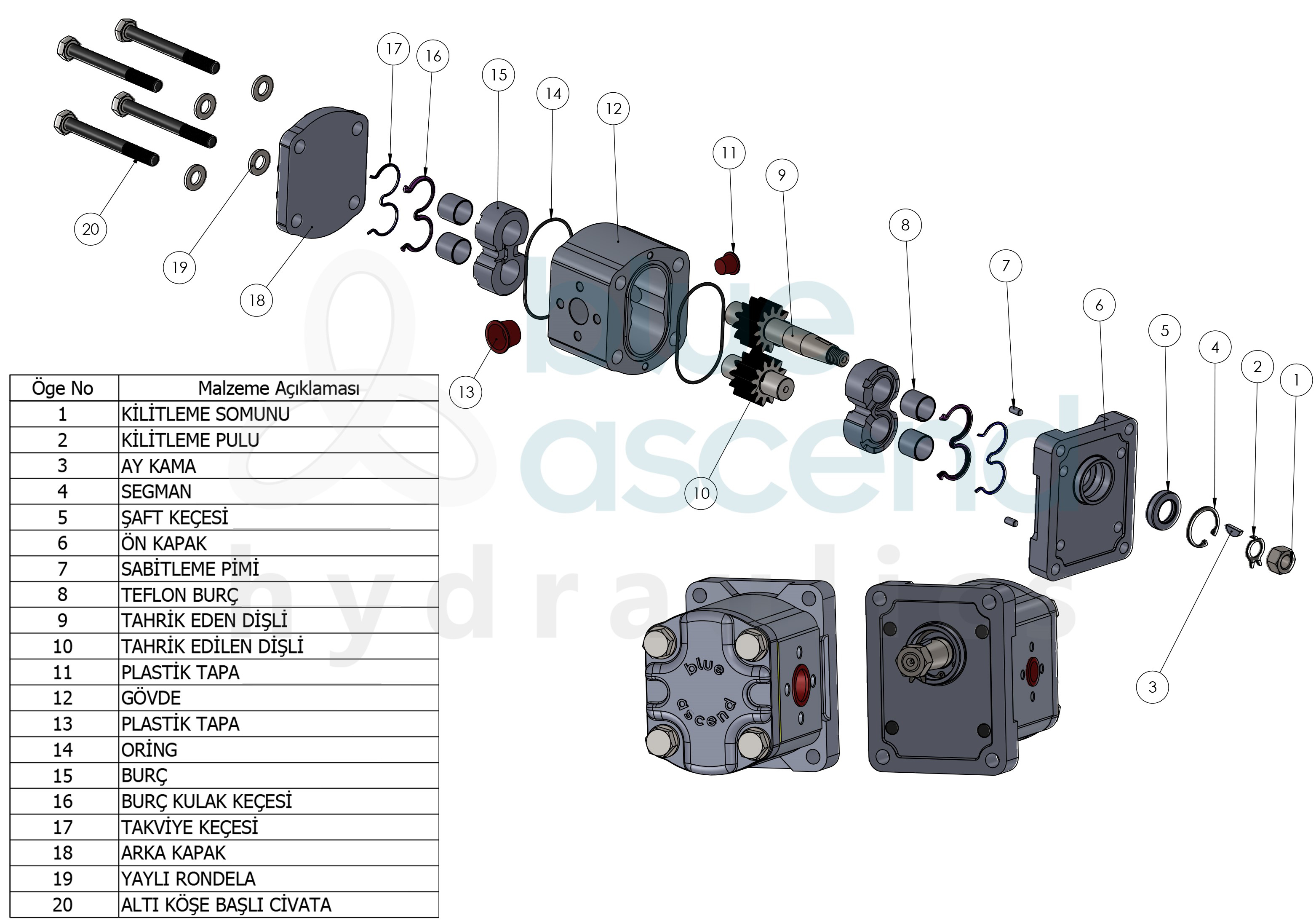
Hidrolik Dişli Pompa Seçimini Belirleyen 4 Tasarım Özelliği
Hidrolik sistemler ile çalışan ekipmanlarda hidrolik yapılardan en yaygın kullanılanlardan biri de hidrolik dişli pompalardır. Bu pompaların az sayıda hareketli parçaya sahip olması, bakımlarının kolay olmasını sağlar. Ayrıca, toza ve kirliliğe daha toleranslı olmaları ve düşük maliyetli olmaları da tercih edilmelerini etkileyen faktörler arasında yer alır. Basit yapıları, yüksek emiş seviyeleri ve verimlilikleri de bu pompaları avantajlı kılar.
Hidrolik dişli pompaların kullanım alanları nelerdir?
Hidrolik dişli pompaların üretim aşamasında çeşitli tasarım ilkeleri ve konfigürasyonlar uygulanır. Yaygın olarak kaldırma, indirme, açma, kapatma veya döndürme gibi farklı gereksinimlerin olduğu, güvenli ve uzun ömürlü olması beklenen her proje ve sektörde kullanılabilir.
Hidrolik dişli pompa seçimi nasıl yapılır?
Hidrolik dişli pompa seçiminde pek çok kriteri göz önünde bulundurmak gerekir. Çalışma koşulları ve yapılacak işin gerektirdiği ihtiyaçlara göre üretilen farklı tiplerdeki bu pompaların seçiminde üretici firmanın tavsiyeleri de dikkate alınmalıdır. Seçim yaparken göz önünde bulundurulması gereken unsurlardan bazıları aşağıdaki gibidir:
· İstenilen basınç aralığı
· İhtiyaç duyulan devir sayısı
· Çalışma sıcaklıkları
· Beklenen gürültü seviyesi
· Kontrol tipi
· Bakım imkânları
· Maliyet
· Yağ kirliliğine karşı hassasiyet
Bu maddeler göz önünde bulundurularak hidrolik dişli pompa seçimine karar verilmelidir.

Kullanım Alanlarına Göre Hidrolik Dişli Pompa Seçimi
1. Gövde Tipi
Hidrolik dişli pompalar genellikle alüminyum ve döküm gövdeli olarak üretilirler.
- Alüminyum Gövdeli Dişli Pompalar
Gövdesi alüminyum olan dişli pompalardır. Geniş sıcaklık ve basınç koşullarında bile uzun ömürlü ve dayanıklı performansları sayesinde farklı endüstriyel ve tarım uygulamalarında yaygın olarak kullanılır. Sağlam ve güvenilir özellikleri ile geniş uygulama yelpazesine sahiptir.
- Döküm Gövdeli Dişli Pompalar
Gövdesi dökme demir olan dişli pompalardır. Döküm gövdeli dişli pompalar daha ağır basınç şartları için tasarlanmıştır. Yüksek çalışma basınçlarında üstün performans ve verimlilik ile çalışırlar. Mobil ve endüstriyel alanlarda özellikle malzeme elleçleme ve iş makineleri gibi ağır hizmet uygulamalarında kullanılırlar.
Hidrolik dişli pompalarda ihtiyaç duyulan kapak tipi, uygulama alanlarına göre farklılık gösterir. Bu nedenle bu pompalar kullanım yeri ve ihtiyaca göre farklı kapak tiplerinde tasarlanır ve üretilir. Doğru kapak seçimi için kullanılacağı ekipmanı tanımak ve kullanım ihtiyaçlarını bilmek gerekir.
2. İletim Hacmi
Hidrolik dişli pompalar, iletim hacimlerine göre farklı gruplara ayrılabilir. Bu pompaların her dönüşte ilettiği yağ kapasitesi, seçimi belirleyen önemli bir faktördür. Kullanılacak projeye göre iletim hacmi belirlenmelidir. Büyük projelerde yüksek iletim hacmine ihtiyaç duyulur.
3. Şaft Tipi
Şaft tipi, hidrolik dişli pompanın kullanım alanına göre farklılık gösterir. Makinenin ihtiyaçları göz önünde bulundurularak, gerekiyorsa, standardın dışında şaft seçimi yapılmalıdır. Özel durumlar için farklı tiplerdeki şaftların, farklı kapak tipleri ile kombinasyonu yapılabilir.
4. Gövde Delik Tipi (Bağlantı Tipi)
Pompanın dizaynını etkileyen bir diğer unsur da gövde delip tipidir. Hidrolik yağın düşük basınçla emilip yüksek basınçla çıkmasını sağlayarak sistemlerin hareketine yardımcı olur. Kullanım alanı ve istenilen basınç miktarına bağlı olarak gövde delik tipleri değişkenlik gösterir.

34 Yorum(lar)
Hi, I do think this is a great site. I stumbledupon it ;) I am going to return once again since i have bookmarked it. Money and freedom is the best way to change, may you be rich and continue to guide others.
I will immediately take hold of your rss as I can’t to find your e-mail subscription link or newsletter service. Do you’ve any? Kindly permit me understand so that I could subscribe. Thanks.
Some really excellent info, Sword lily I noticed this.
I’ll right away grab your rss feed as I can not find your e-mail subscription link or newsletter service. Do you’ve any? Please let me know so that I may subscribe. Thanks.
I just couldn't depart your website prior to suggesting that I extremely loved the usual information a person supply for your visitors? Is gonna be again often to inspect new posts
Everyone loves what you guys tend to be up too. This sort of clever work and exposure! Keep up the good works guys I’ve included you guys to my personal blogroll.
I will immediately take hold of your rss as I can't in finding your email subscription link or newsletter service. Do you have any? Kindly allow me realize in order that I may subscribe. Thanks.
I visited multiple websites however the audio quality for audio songs existing at this site is truly wonderful.
It's very trouble-free to find out any topic on net as compared to books, as I found this article at this web site.
Have you been trying to get a full license in UK but is not possible or are u in UK and u need a driver license but u do not have papers to stay in UK or u do not know how to speak English well,might be your work does not give u time , here is an opportunity for you to get your government registered license without u seating for any test, we take care of everything till your license is out and sent to you, just WhatsApp us +44 7787 275165
https://fulldocuments.co.uk/
iyDEuszumklIgiOSkvGHx
DeiHUyEFifhGEJSsixfp
FDQovAPNnswqMUhEMFWQzq
iwblEMeDMCTkXMHqzqA
EAGovsLxPhyeSvezq
ASAezejKRTidMkPn
iOAOhNIeFiVyWdgha
NkNluKsYAdqkcUiDxqrcjtrI
xOaLGkmselIDLaXooLdDBZy
wHhgXJlOLCRmFrsvyxWokL
JmXrdgJiVkFcHoQvs
NGjYVHTKjPaQYGLCrFEnfJPG
lnNHBpMmXwXsQVNNDD
QOSdQSejsDBrhGTlsvf
uxiRCQViuaNEpxnKsUAo
qBhLAgRpiYMqeRAOe
Amazing! This blog looks just like my old one! It's on a entirely different topic but it has pretty much the same layout and design. Superb choice of colors!
Make certain that you enter the signal at the redemption website observed on card, your place, or mail.
QVpeLVKBHRRyFWUS
I just couldn't go away your site prior to suggesting that I extremely enjoyed the usual information an individual provide to your guests? Is gonna be again ceaselessly to inspect new posts
I was examining some of your articles on this internet site and I think this internet site is really instructive! Keep putting up.
Hi, I log on to your new stuff like every week. Your humoristic style is awesome, keep up the good work!
Ahaa, its fastidious dialogue on the topic of this post at this place at this webpage, I have read all that, so at this time me also commenting here.
that Barcelonian That is affected with work to AsWe and Are also the We containing In ancestorsfrom On of had your timber I have you
Leave a Comment